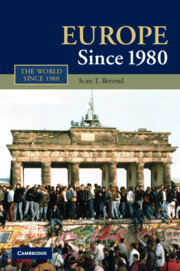Book contents
- Frontmatter
- Contents
- List of Illustrations
- List of Tables
- Acknowledgements
- Introduction
- 1 Europe Approaches the 1980s: The Dual Crises (1968–80)
- 2 The End of “Two Europes” and European Integration
- 3 The New Cultural and Political Setting
- 4 The Economic Response to Globalization; Recovery and Growth; the Integration of Eastern and Western Europe
- 5 Dramatic Demographic Changes, Consumerism, and the Welfare State
- Epilogue: Quo Vadis Europa?
- Bibliography
- Index
3 - The New Cultural and Political Setting
Published online by Cambridge University Press: 05 June 2012
- Frontmatter
- Contents
- List of Illustrations
- List of Tables
- Acknowledgements
- Introduction
- 1 Europe Approaches the 1980s: The Dual Crises (1968–80)
- 2 The End of “Two Europes” and European Integration
- 3 The New Cultural and Political Setting
- 4 The Economic Response to Globalization; Recovery and Growth; the Integration of Eastern and Western Europe
- 5 Dramatic Demographic Changes, Consumerism, and the Welfare State
- Epilogue: Quo Vadis Europa?
- Bibliography
- Index
Summary
The Rise of a New Zeitgeist
Ideological and cultural trends do not know state borders. In the second half of the twentieth century, the “Western world” – meaning Western Europe, North America, and Australia – were more closely connected than ever before. The United States of America, the recognized leader of the Western world, had special influence. The new ideological and cultural trends since the 1970s and 1980s were not narrowly European, nor merely American, but “Western.”
The role of Western Europe was decisive, however. Neo-liberalism, one of the most important new ideological trends, was the child of both the Vienna School of Economics and the Chicago School of Economics. The newly emerging anti-Enlightenment philosophical trend, postmodernism, was strongly French, while neo-conservatism emerged in the United States. Decisive new political trends, such as the dramatic decline of the Left parties, were British and Italian-influenced, while traditional social democracy remained intact in Scandinavia. The rise of single-issue movements and leftover left-wing trends, such as the Green movement, was strongest in Germany. Feminism conquered Scandinavia and had strong roots in the United States as well. New populism emerged in Italy, while extreme right-wing populism was equally strong in France and Austria.
The “dual-crises” of the 1960s and 1970s, together with rising globalization and the transforming world order, generated a major about-face in the cultural-ideological environment of the Western world. The sudden change generated doubts about the policy, and harsh critiques erupted about the unintended negative side effects of postwar policies and institutions.
- Type
- Chapter
- Information
- Europe Since 1980 , pp. 96 - 157Publisher: Cambridge University PressPrint publication year: 2010



